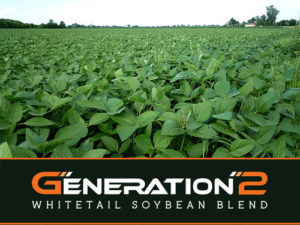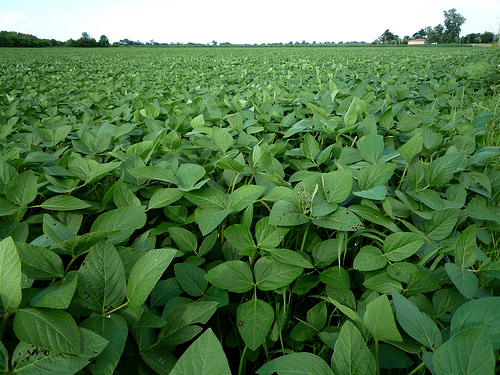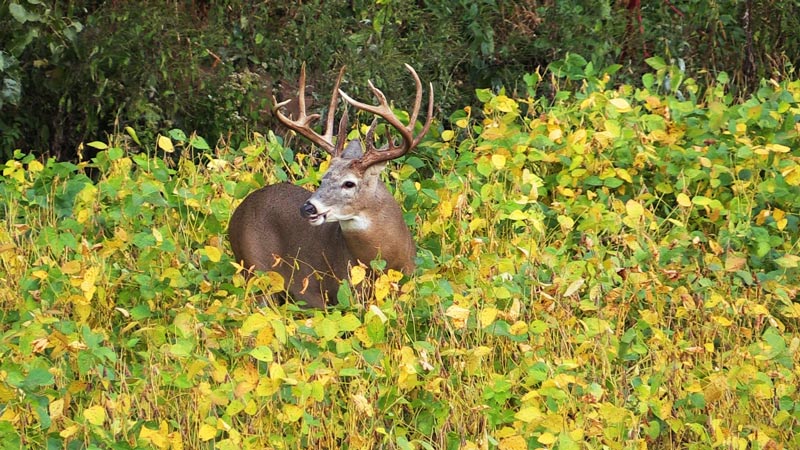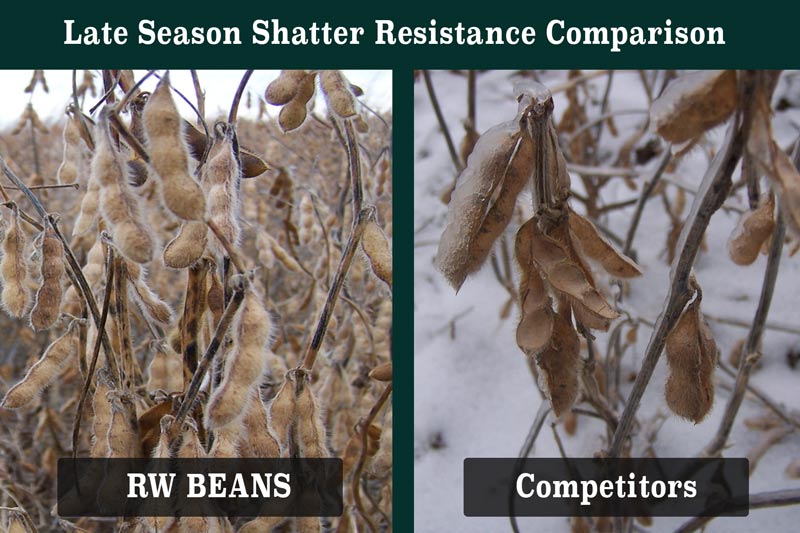
Across the Midwest it is almost time for food plotters to get those spring-planted plots planted. Many of us have recognized the numerous benefits of including soybeans in our food plot programs. The greatest of those benefits is that soybeans provide a nutrient-rich food-source from the time they germinate until the very last grain is consumed in the winter. Very few other plants can compete with the protein levels of soybeans during the green growing phase and when it comes to late-fall and winter, I know of nothing that will provide the protein levels at that time of year.
Recognizing the value of soybeans for whitetail foodplots is only step one in the process. The question then becomes; are you planting the BEST soybean in your whitetail food plots? If so, how do you know? Are you listening to others and following their advice or have you done side-by-side tests on your own property to know for sure? If your whitetail hunting success is important to you (and I am sure it is), I suggest you make 2019 the year that you find out for certain just which soybean is the best on YOUR property.
 Let’s look at some of your soybean options. Forage soybeans gained favor with food plotters across much of the country because of their increased volume of green forage. What is gained in green forage however, is lost in grain production. Forage soybeans are typically at their best during the summer and early fall when quality food sources are abundant but later in the fall they offer very little. Forage soybeans probably have their place in southern states but here in the Midwest I consider an acre planted to forage soybeans as an acre wasted and I say this after 5 consecutive years of side-by-side trials on my own farm that included forage soybeans.
Let’s look at some of your soybean options. Forage soybeans gained favor with food plotters across much of the country because of their increased volume of green forage. What is gained in green forage however, is lost in grain production. Forage soybeans are typically at their best during the summer and early fall when quality food sources are abundant but later in the fall they offer very little. Forage soybeans probably have their place in southern states but here in the Midwest I consider an acre planted to forage soybeans as an acre wasted and I say this after 5 consecutive years of side-by-side trials on my own farm that included forage soybeans.
Another option to consider is “ag soybeans”, or the same soybeans that farmers plant in their farm fields. This can certainly be a viable option but really is like playing Russian roulette with your food plots. Years ago I also planted ag soybeans in my plots. Some years it worked great but other years it was a disaster as the soybean pods shattered open and spilled the grain onto the ground, often into mud or snow where it was worthless to hungry whitetails. With literally thousand of different soybean varieties available you may get lucky and plant a winner or you might find out too late that you picked one that doesn’t work so well. Is that a chance you want to take?
 If one were to trace the roots of Real World Wildlife Products, it actually started on my home farm and my frustration with both ag soybeans and forage soybeans. I planted both with much frustration for years before the thought ever crossed my mind to start a new seed company. I simply started testing various varieties of soybeans to find a variety that would not shatter late into the winter. Initially this was just for my own use without consideration of ever marketing the end result. This is simply a very brief summary of the first stage in the development of Real World soybeans to show that I once planted both forage soybeans and ag soybeans in my plots. If either had worked, there very well may not be a Real World Wildlife Products company today. The history of Real World soybeans goes many levels deeper as Real Worlds experience and knowledge regarding soybeans expanded over the years.
If one were to trace the roots of Real World Wildlife Products, it actually started on my home farm and my frustration with both ag soybeans and forage soybeans. I planted both with much frustration for years before the thought ever crossed my mind to start a new seed company. I simply started testing various varieties of soybeans to find a variety that would not shatter late into the winter. Initially this was just for my own use without consideration of ever marketing the end result. This is simply a very brief summary of the first stage in the development of Real World soybeans to show that I once planted both forage soybeans and ag soybeans in my plots. If either had worked, there very well may not be a Real World Wildlife Products company today. The history of Real World soybeans goes many levels deeper as Real Worlds experience and knowledge regarding soybeans expanded over the years.
Today I am absolutely convinced that Real Worlds Generation-2 soybeans are the very best soybean option for food plotters in the Midwest and Northeast areas of the country. They also are proving to be a very good option in southern states as well. Literally hundreds of soybean varieties have been tested to come up with the 4 varieties that are in Generation-2 soybeans. Don’t take my word for it however. You need to see it for yourself on your own land.
 On numerous occasions I have talked to other food plotters about their soybean plots and they will say that they have always planted a different soybean in the past but this year they are switching to Real World soybeans. I always encourage them NOT to do a complete switch because then they are trying to make a comparison across different years with uncontrollable variables such as weather. I ask them to continue planting the same soybean they have been planting on half of their acreage and plant Real World soybeans on the other half and if possible plant the two different soybeans side-by-side. This allows a fair comparison under the same growing conditions and the differences are then very easy to see. Most importantly this gives them a fair comparison on their own property. That sure beats getting information off of the internet where every keyboard jockey is an expert at all things whitetail. I also caution to not draw conclusions too soon with these side-by-side trials. Early on it might seem that there is little difference but the later the test goes on into the late fall and winter months, the more the Real World soybeans will outperform the competition.
On numerous occasions I have talked to other food plotters about their soybean plots and they will say that they have always planted a different soybean in the past but this year they are switching to Real World soybeans. I always encourage them NOT to do a complete switch because then they are trying to make a comparison across different years with uncontrollable variables such as weather. I ask them to continue planting the same soybean they have been planting on half of their acreage and plant Real World soybeans on the other half and if possible plant the two different soybeans side-by-side. This allows a fair comparison under the same growing conditions and the differences are then very easy to see. Most importantly this gives them a fair comparison on their own property. That sure beats getting information off of the internet where every keyboard jockey is an expert at all things whitetail. I also caution to not draw conclusions too soon with these side-by-side trials. Early on it might seem that there is little difference but the later the test goes on into the late fall and winter months, the more the Real World soybeans will outperform the competition.
If you have never planted Real Worlds Generation-2 soybeans maybe 2019 is the year you need to see just how they compare with the soybeans you have been planting. It is easy to say you have a great soybean plot and don’t need to try another variety but the question becomes; what if there is a better soybean option? And what if your neighbor plants it? That’s a chance that I am not willing to take. Shatter resistance is just one benefit. Higher oil content of Real World soybeans make them more palatable and thus more attractive. Once you see it, you will become a believer.